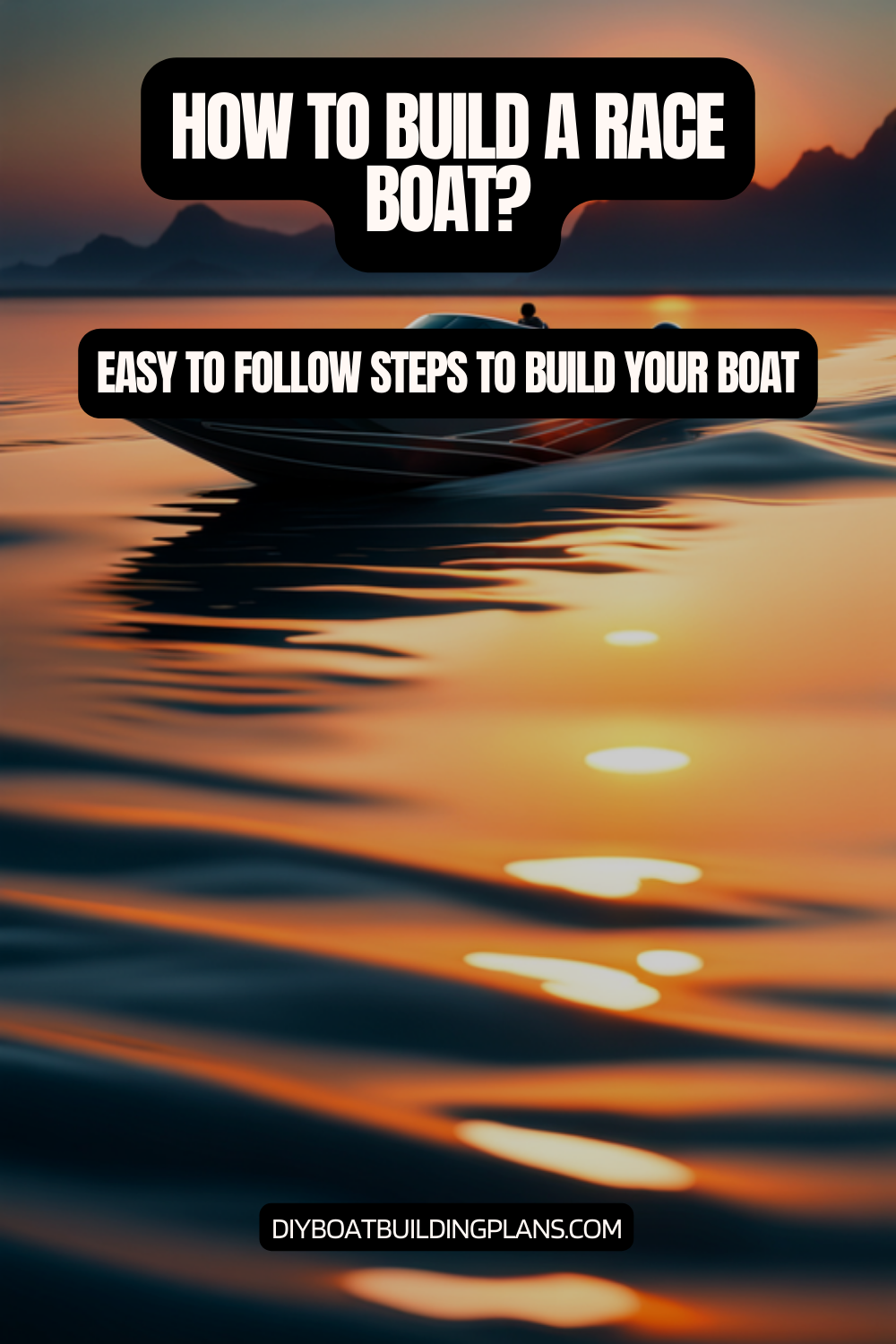Ever wondered how people turn simple materials into fast racing boats? DIY boatbuilding is a thrilling challenge for those who love making things. It lets you build your dream race boat from the ground up.
Building a boat at home needs careful planning, technical skills, and creative thinking. It doesn’t matter if you’re a casual builder or a serious marine fan. Creating your own race boat is a rewarding mix of engineering and personal touch.
Designing a race boat is more than just making it look good. It’s about knowing how water moves, the strength of materials, and how to make it fast. Every choice you make affects how well your boat will go and how safe it is.
Key Takeaways – How To Build a Race Boat
- DIY boatbuilding demands careful planning and technical knowledge
- Understanding boat design principles is key to success
- Choosing the right materials is vital for performance
- Being precise in building is important for racing
- Building a boat at home brings unique satisfaction
- Always put safety first

Understanding the Basics of Race Boat Design
Race boat design is a mix of engineering and creativity. It needs to know about hydrodynamics, materials, and how to make things better. This knowledge is key to building a fast boat.
There are many types of race boat hulls. Each one is special and affects how the boat performs. Knowing about these designs is important for making a boat that can win.
Overview of Race Boat Types
Race boats have different shapes:
- Tunnel Hulls: Great for going fast in a straight line
- Catamarans: Very stable and cut through water well
- Monohulls: Classic design that works well in many ways
Key Design Elements
Important parts of race boat design are:
- A shape that cuts through water easily
- Weight spread out right
- Strong enough for tough conditions
Materials Used in Construction
Fiberglass has changed how race boats are made. The main materials are:
| Material | Advantages | Best Used For |
|---|---|---|
| Fiberglass | Light, strong | Fast racing boats |
| Carbon Fiber | Very strong, light | Top-level racing boats |
| Marine-Grade Plywood | Affordable, classic | Fun boats and beginner racers |
“The perfect race boat design is a delicate balance between form, function, and innovative engineering.” – Naval Architecture Expert
Knowing the basics of race boat design is the first step to making a fast and competitive boat.
Tools and Equipment Needed
Starting a boat assembly project needs careful planning and the right tools. DIY boatbuilding requires precision and skill. You also need a well-equipped workspace for success. Knowing the essential tools and safety gear is key before you begin.
Essential Tools for Boat Building
Professional boat builders suggest a detailed toolkit for DIY boatbuilding. Important tools include:
- Power drill with multiple drill bits
- Saber saw for precise cutting
- Hand power planer for smoothing surfaces
- Belt sander for finishing
- Hack saw for metal cutting
- Miter box for accurate angle cuts
- Table saw for precise woodworking
Safety Gear for Woodworking
Keeping yourself safe during boat assembly is vital. Essential safety gear includes:
- Safety goggles to protect eyes from debris
- Heavy-duty work gloves
- Dust mask for respiratory protection
- Ear protection when using power tools
- Protective work boots
“Proper safety gear is not an option, it’s a necessity in DIY boatbuilding.” – Professional Boat Builder
Workbench Setup
A well-organized workbench is key for efficient boat assembly. Here are some workspace tips:
| Workspace Requirement | Recommendation |
|---|---|
| Workspace Size | Minimum 10×10 feet with good ventilation |
| Lighting | Bright, even illumination |
| Temperature | 10-25°C for optimal working conditions |
| Work Surface | Stable, level workbench with clamp capabilities |
Investing in quality tools and setting up a safe, organized workspace will greatly improve your DIY boatbuilding experience and results.
Planning Your Race Boat Project
Designing a race boat needs careful planning and smart thinking. Starting with a detailed design and performance goals is key. Race boat design requires precision, creativity, and technical skills to meet your racing needs.
Before starting construction, create a detailed project plan. This plan should cover important boat design aspects:
Creating a Design Sketch
Your first design sketch is the base of your project. Think about these important points when making your initial plans:
- Boat’s racing purpose
- Hull shape and design
- Performance needs
- Material choices
Calculating Dimensions and Weight
Accurate measurements are vital in race boat design. Experts use specific formulas to find the best dimensions:
- Crew weight displacement: About 60 pounds per cubic foot of water
- Length-to-width ratio
- Total weight including gear
“In race boat design, every ounce matters. Precision trumps compromise.” – Michael Storer, Boat Design Expert
Determining Performance Goals
Set clear performance goals to guide your boat building. Think about these key factors:
- Top speed goal
- Maneuverability
- Stability in various waters
- Acceleration
By carefully planning your race boat project, you’ll lay a strong foundation for a high-performance vessel. This will help you achieve your racing goals.
Unlock the secrets to building your dream boat with MyBoatPlans! With detailed plans for over 518 boats and expert video tutorials, you’ll have everything you need to create your perfect vessel. Click here to begin your journey!
Choosing the Right Materials
Building a race boat needs careful material selection. You want materials that are good for performance, last long, and are affordable. Today, there are many new materials that are better than old ones.
Fiberglass boat fabrication is now the top choice for most builders. It’s popular because it has many benefits over other materials.
Wood vs. Composite Materials
Wooden boats were once common, but they have big downsides:
- High maintenance costs
- Potential structural degradation
- Expensive repairs
Fixing wooden boats can cost over $100,000. This makes fiberglass a better choice. Fiberglass is durable, easy to maintain, light, and resists damage from the environment.
Recommended Supplier Options
Finding good suppliers is key for quality materials. Look for stores that sell marine-grade composites and fiberglass.
Budgeting for Materials
| Material | Cost Range | Durability Rating |
|---|---|---|
| Fiberglass | $50-$200/sq ft | High |
| Marine Plywood | $30-$150/sheet | Medium |
| Aluminum | $100-$300/sq ft | High |
“Invest in quality materials upfront to save on long-term maintenance and repair costs.” – Marine Engineering Expert
Knowing about boat materials helps you choose wisely. It’s about finding the right mix of performance, cost, and durability for your race boat.
Building the Hull
Making the perfect hull is key in DIY boatbuilding. It needs precision, patience, and planning. This ensures the boat performs well on the water.
Building a boat starts with knowing the basics. These basics turn raw materials into a fast, sleek watercraft. DIY fans must focus on several important hull aspects.
Preparing the Frame
A strong frame is the boat’s foundation. Use materials that are strong and last long:
- High-quality marine plywood
- Lightweight yet strong timber frames
- Precision-cut structural supports
Planking Techniques
Planking methods greatly affect your boat’s performance. Here are the top methods:
| Planking Method | Characteristics | Best Used For |
|---|---|---|
| Carvel Planking | Smooth exterior surface | Racing boats |
| Lapstrake | Overlapping planks | Traditional designs |
| Strip-Planking | Lightweight and flexible | High-performance hulls |
Shaping the Hull
“The perfect hull is a balance between art and science” – Professional Boat Builder
Shaping the hull needs careful focus on how it moves through water. Use templates and guides for:
- Symmetrical design
- Smooth exterior curves
- Optimal water displacement
Pro tip: Think about the boat’s purpose when shaping the hull. Racing boats need different shapes than leisure boats.
Installing the Deck
Deck installation is a key part of making your boat ready for the water. It turns a simple frame into a fully functional boat. The deck is the heart of your boat, where function meets design.
Installing the deck needs careful planning and precise work. Builders must pay close attention to every detail. This ensures the boat performs well and looks great.
Deck Layout and Design
When designing your deck, keep these points in mind:
- Optimal weight distribution
- Strategic placement of controls
- Ergonomic seating arrangements
- Integrated storage solutions
Securing the Deck
Attaching the deck right is key for a solid boat. Use strong adhesives and fasteners for a tight bond. Here are some tips:
- Apply epoxy coatings (at least 2 coats)
- Use 3/4 inch #6 particle board screws
- Implement 3/16 fender washers for additional support
Finishing Touches
Adding the final touches can make your boat stand out. Think about these upgrades:
- Non-skid surface treatments
- Custom trim elements
- Watertight joint seals
- Strategically placed hatches
“The deck is not just a surface, but the canvas where your boat’s personality comes to life.” – Boat Building Enthuasiast
Pro tip: Measure and check for pinch points to ensure smooth deck integration during assembly.
Download over 500 Boat Plans. Click on the link below.
-->Click Here<--
Installing the Steering System
Choosing the right steering system is key for a successful boat. It’s the main control point for your watercraft. It affects how well the boat handles and responds.
Race boat designers see the steering system as more than just a part. It’s the link between the boat and the driver. Each type of steering system has its own benefits for different racing needs.
Types of Steering Systems
- Mechanical Steering: Great for smaller boats with direct cable connections
- Hydraulic Steering: Smooth operation for larger racing boats
- Electronic Steering: Precise control for advanced race boat designs
Installation Considerations
When installing your steering system, precision is essential. Here are some key stats for a successful installation:
| Component | Critical Specification |
|---|---|
| Shaft Diameter | 5/8 inch stainless steel |
| Attachment Method | Four through-bolts for secure mounting |
| Performance Range | Operational in 3-6 knot wind conditions |
“A well-installed steering system can make the difference between victory and defeat on the racecourse.” – Professional Racing Boat Designer
Step-by-Step Installation Guide
- Carefully measure and mark mounting locations
- Drill precise holes for secure attachment
- Install steering wheel and connection mechanisms
- Test system responsiveness before final setup
- Lubricate moving parts for smooth operation
Warning: About 50% of factory-rigged boats need a lot of rework. Always check your installation for safety and performance.
Choosing the Right Engine
Finding the perfect engine is key in race boat design. It can make or break your performance on the water. The right engine turns a regular boat into a high-speed racing machine.
Race boat fans know engine selection is more than just horsepower. It’s about finding the right mix of power, weight, and design.
Understanding Engine Types
Race boat engines have three main types:
- Outboard Engines: Lightweight and simple to keep up
- Inboard Engines: Better for weight distribution
- Jet Drive Engines: Great for unique moves
Horsepower Considerations
Choosing the right horsepower for your boat is vital. Here’s a quick guide to help:
| Boat Length | Recommended Horsepower | Performance Level |
|---|---|---|
| 12-15 feet | 50-90 HP | Recreational Racing |
| 16-20 feet | 90-250 HP | Intermediate Racing |
| 21-25 feet | 250-400 HP | Professional Racing |
Engine Mounting Process
Installing a boat engine needs precision and care. Important steps include:
- Make sure weight is evenly distributed
- Check if mounting points are strong
- Verify alignment and clearances
- Put in vibration dampeners
“The right engine can turn a good boat into a great racing machine.” – Professional Boat Builder
Pro tip: Always talk to marine engineering experts when picking and installing your race boat engine. This will help boost performance and safety.
Finalizing Electrical Systems
Finishing the electrical system is key in DIY boatbuilding. It can greatly affect your boat’s performance. A good electrical setup ensures your boat works well and safely on the water.
Electrical Components Overview
When setting up your boat’s electrical system, think about several important parts. These parts work together to power your boat. The right setup can turn your DIY project into a pro-level boat.
- Marine-grade battery
- Waterproof switches
- Appropriate fuse box
- Marine-rated wiring
Installing Navigation Lights
Navigation lights are more than just a nice feature. They are a must for boat safety. Proper installation makes sure your boat is seen and follows the rules of the sea.
Safety first: Always follow official boating regulations when installing electrical components.
Battery and Wiring Setup
Choosing the right battery and wiring is vital for your boat. Marine environments need special parts that can handle moisture and movement.
| Component | Recommended Specification | Price Range |
|---|---|---|
| Marine Battery | Deep Cycle 12V | $150-$300 |
| Marine Wiring | 10-14 Gauge Tinned Copper | $0.50-$2 per foot |
| Waterproof Connectors | Heat-Shrink Style | $20-$50 kit |
Today’s DIY boatbuilding focuses on quality electrical parts. Think about adding extras like bilge pumps, marine radios, and GPS systems. These can make your boat even better.
Painting and Finishing Your Race Boat
Finishing your boat project needs careful attention to painting and finishing. The look of your race boat depends on good preparation and skill in applying paint.
Building a boat requires precision in painting. Boat experts say to prepare the surface well before painting.
Surface Preparation Techniques
- Clean the boat surface completely
- Sand the surface uniformly
- Remove all existing paint and debris
- Repair any surface imperfections
- Apply quality marine primer
Choosing the Right Paint
Boat lovers often pick between two paints:
- One-part polyurethane: It’s cheaper and easier to use
- Two-part polyurethane: It lasts longer and looks better
“Practice on smaller projects like oars or a dinghy before painting an entire hull” – Professional Boat Builder Advice
Professional Finishing Tips
For DIY projects, follow these tips:
- Use roll-and-tip method for smooth application
- Apply thin, consistent paint coats
- Allow proper drying time between layers
- Use high-quality natural bristle brushes
- Work in controlled temperature conditions
The look of your race boat shows the effort and skill in building it. Make sure to do each painting step well.

Launching and Testing Your Race Boat
After finishing your boat, the fun part starts with launching and testing. It’s important to prepare well to make sure your boat works great and is safe on the water.
First, test your boat’s performance in calm water. Check everything, like steering, engine, and how it balances. Use tools or timers to measure speed, stability, and how easy it is to steer.
Keep track of how your boat does by making small changes. Try different weights, angles, and engine settings. Some say to test three versions to find the best one. Look at things like hull thickness, sail size, and balance to get the most speed and reliability.
Remember, safety is key during testing. Wear the right gear, have an adult nearby, and be ready to make changes. With patience and careful testing, your homemade race boat will be ready for races.
FAQ
How long does it take to build a race boat at home?
The time needed depends on your skill, the boat’s complexity, and how much time you have. Most DIY fans take 3 to 12 months. If you’re more experienced, you might finish quicker. Beginners could need up to 18 months.
What is the most challenging part of building a race boat?
Building the hull is the toughest part. It needs precision and patience to get the hydrodynamic shape right. You must focus on symmetry, material quality, and smooth curves.
How much does it cost to build a race boat at home?
Prices vary from $5,000 to $50,000, based on size, materials, and complexity. A simple DIY boat might cost $10,000. A high-end custom boat could be over $30,000. Plan your budget for materials, tools, engine, and finishing.
Do I need professional experience to build a race boat?
You don’t need to be a pro, but it helps. Many start as hobbyists. You’ll need patience, mechanical skills, and a willingness to learn. Workshops, videos, and expert advice can help.
What are the most critical safety considerations?
Safety first includes using marine-grade materials and wearing protective gear. Make sure the structure is strong, the steering and engine work well, and follow safety rules. Always be careful during building and testing.
Can I build a race boat if I have limited workspace?
You don’t need a huge space. A two-car garage or a well-organized workshop is enough. Make sure you have room for tools, materials, and building. Good ventilation and lighting are more important than space.
What type of materials work best for a beginner?
Beginners should start with marine-grade plywood or fiberglass. Plywood is easier and cheaper, while fiberglass is durable and lighter. Start simple and move to more advanced materials as you get better.
How do I determine the right engine for my race boat?
Choose an engine based on boat size, weight, and what you want to do with it. Think about horsepower-to-weight ratio, use, and budget. Get advice from experts, check specs, and test different engines to find the best one.
What common mistakes should I avoid when building a race boat?
Avoid poor planning, bad material choices, ignoring hull symmetry, and rushing. Take your time to research, plan well, follow detailed plans, and ask for advice from pros.
How important is weight distribution in race boat design?
Weight distribution is key for speed, stability, and handling. Wrong weight placement can hurt performance and safety. Plan carefully, balancing weight across the hull, considering engine, crew, and equipment placement.



